Understanding Cisco IOS Gatekeeper Call Routing
Available Languages
Contents
Introduction
Cisco gatekeepers are used to group gateways into logical zones and perform call routing between them. Gateways are responsible for edge routing decisions between the Public Switched Telephone Network (PSTN) and the H.323 network. Cisco gatekeepers handle the core call routing among devices in the H.323 network and provide centralized dial plan administration. Without a Cisco gatekeeper, explicit IP addresses for each terminating gateway would have to be configured at the originating gateway and matched to a Voice over IP (VoIP) dial-peer. With a Cisco gatekeeper, gateways query the gatekeeper when trying to establish VoIP calls with remote VoIP gateways.
For example, when presented with a call, the gateway determines whether to send it to the telephony leg or to the IP leg according to its dial plan. In the case of the IP leg, the gateway queries the Cisco gatekeeper to select the best endpoint. Then, the Cisco gatekeeper determines if the called endpoint is a device within its local zone or it is located at a remote zone controlled by a remote Cisco gatekeeper.
Prerequisites
Requirements
Cisco recommends that you have knowledge of Understanding H.323 Gatekeepers.
Components Used
The information in this document is based on these software and hardware versions:
-
Cisco 2500, 2600, 3600, 3700, 7200, and MC3810 Series Routers
-
This document is not specific to any version of Cisco IOS®. However, the configurations in this document were tested on Cisco IOS Software Release 12.2(19). Refer to the Software Advisor (registered customers only) to confirm the Cisco IOS feature set needed to support the H.323 Gatekeeper functionality.
The information in this document was created from the devices in a specific lab environment. All of the devices used in this document started with a cleared (default) configuration. If your network is live, make sure that you understand the potential impact of any command.
Conventions
Refer to Cisco Technical Tips Conventions for more information on document conventions.
ARQ and LRQ Messages
Admission Request (ARQ) and Location Request (LRQ) are the two H.225 Registration, Admission, Status (RAS) messages that trigger a gatekeeper to initiate the call routing decision process.
-
ARQ—Local zone messages that are sent by H.323 endpoints (usually gateways) to the Cisco gatekeeper. Gatekeepers receive ARQs from an endpoint if:
-
A local zone endpoint initiates a call. OR
-
A local zone endpoint request permission to admit an incoming call.
Gatekeepers reply to ARQ messages with an Admission Confirm (ACF) or an Admission Reject (ARJ) message. If the Cisco gatekeeper is configured to admit the call, it replies with an ACF message (which includes information such as destination gateway IP address). If not, it replies with an ARJ message.
-
-
LRQ—These messages are exchanged between gatekeepers and are used for inter-zone (remote zone) calls. For example, gatekeeper A receives an ARQ from a local zone gateway requesting call admission for a remote zone device. Gatekeeper A then sends an LRQ message to gatekeeper B. Gatekeeper B replies to the LRQ message with either a Location Confirm (LCF) or Location Reject (LRJ) message, which depends on whether it is configured to admit or reject the inter-zone call request and whether the requested resource is registered.
Refer to Understanding H.323 Gatekeepers: Gatekeeper to Gateways Call Flow for more information.
| Related H.225 RAS Messages | |||
|---|---|---|---|
| ARQ | Admission Request | LRQ | Location Request |
| ACF | Admission Confirm | LCF | Location Confirm |
| ARJ | Admission Reject | LRJ | Location Reject |
Important Configuration Concepts: Zone and Technology Prefixes
In order to understand the Cisco gatekeeper call routing decision process, it is essential to understand zone and technology prefixes. In general (with a few exceptions), the zone prefix determines the routing to a zone, whereas the technology prefix determines the gateway in that zone.
Zone Prefixes
A zone prefix is the part of the called number that identifies the zone to which a call hops off. Zone prefixes are usually used to associate an area code to a configured zone.
The Cisco gatekeeper determines if a call is routed to a remote zone or handled locally. For example, according to this configuration excerpt, gatekeeper (GK) A forwards 214....... calls to GK-B. Calls to area code (512) are handled locally.
gatekeeper
zone local GK-A abc.com
zone remote GK-B abc.com 172.22.2.3 1719
!--- The IP address configured above should be the RAS !--- address of the remote gatekeeper. !--- and should be reachable from the local gateway. !--- In order to find out the RAS address on the remote gatekeeper, !--- issue the show gatekeeper zone status command !--- on the remote gateway.
zone prefix GK-B 214.......
zone prefix GK-A 512.......
Technology Prefixes
A technology prefix is an optional H.323 standard-based feature, supported by Cisco gateways and gatekeepers, that enables more flexibility in call routing within an H.323 VoIP network. The Cisco gatekeeper uses technology prefixes to group endpoints of the same type together. Technology prefixes can also be used to identify a type, class, or pool of gateways.
Cisco gatekeepers use technology prefixes to route calls when there is no E.164 addresses registered (by a gateway) that matches the called number. In fact, this is a common scenario because most Cisco IOS gateways only register their H.323 ID (unless they have Foreign Exchange Station (FXS) ports configured). Without E.164 addresses registered, the Cisco gatekeeper relies on two options to make the call routing decision:
-
With the Technology Prefix Matches option, the Cisco gatekeeper uses the technology prefix appended in the called number to select the destination gateway or zone.
-
With the Default Technology Prefixes option, the Cisco gatekeeper assigns default gateway(s) for routing unresolved call addresses. This assignment is based on the gateways' registered technology prefix.
This table summarizes available configuration options:
| On the Gateway | |
|---|---|
| VoIP Interface | This command registers the Cisco gateway with the defined technology prefix. The technology prefix registration information is sent to the Cisco gatekeeper in the RAS Registration Request (RRQ) message. For example: GWY-B1(config)#interface ethernet 0/0
GWY-B1(config-if)#h323-gateway voip tech-prefix ?
WORD: A technology prefix that the interface will register
with the Gatekeeper. |
| VoIP Dial-peer | This command prepends a technology prefix to the called number matched by the dial-peer. It is not used for registration, but for call setup with the Cisco gatekeeper. For example, called number 5551010 becomes 1#5551010. GWY-B1(config)#dial-peer voice 2 voip
GWY-B1(config-dial-peer)#tech-prefix ?
WORD: A string. Note: The modified called number is also sent to the terminating gateway in the call setup. Ensure the terminating gateway plain old telephone service (POTS) dial-peers are updated to complete the call. |
| On the Gatekeeper | |
|---|---|
| Gatekeeper Default Technology Prefix | This command sets registered gateways with the specified technology prefix as default for routing call addresses that are unresolved. For example, if most gateways in your zone route the same type of calls and they are registered with technology prefix 1#, you can configure the Cisco gatekeeper to use 1# as the default technology prefix. Therefore, it is no longer necessary for originating gateways to prepend the called number with 1#. Called numbers without a valid technology prefix are routed to one of the gateways registered with 1#. GK-B(config)#gatekeeper GK-B(config-gk)#gw-type-prefix 1# default-technology Note: If there is more than one default gateway, you can affect the gateway priority usage with the zone prefix <gk_id> <e.164_pattern> gw-priority <0-10> command. |
| Gatekeeper Hop-Off Zone | Hop-off configurations are used to override the zone prefix selection and force the call to be hopped-offed to a specified zone, regardless of the called number zone prefix. For example, with this configuration, all calls with technology prefix 2# will be forwarded to the GK-A zone. GK-B(config)#gatekeeper GK-B(config-gk)#gw-type-prefix 2# hopoff GK-A |
| Gatekeeper Static Gateway Technology Prefix Registration | Used to statically register a technology prefix for a gateway. It accomplishes the same results on the gatekeeper as the gateway VoIP interface configuration achieves on the gateway . It is recommended to configure this on the gateways if you have a large number of gateways. Generally, it is easier to configure each gateway with a technology prefix than to configure the gatekeeper with all technology prefixes for each gateway. GK-B(config)#gatekeeper
GK-B(config-gk)#gw-type-prefix 1# gw ipaddr ?
A.B.C.D Gateway's call signaling IP address |
The Gatekeeper Call Routing Algorithm / Decision Process
These diagrams display the gatekeeper call routing decision process after receiving ARQ and LRQ messages in Cisco IOS Software Releases before 12.4:
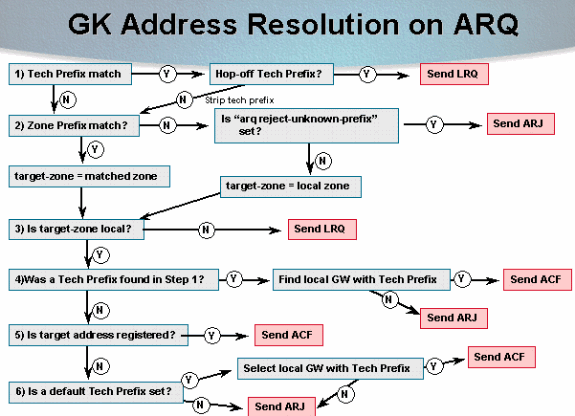
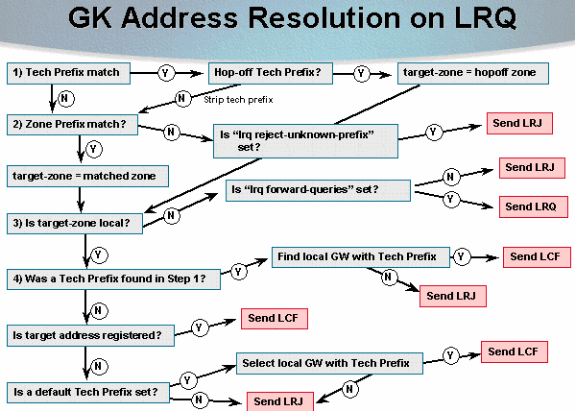
Alias-Based Call Routing
The gatekeeper call routing has changed in Cisco IOS Software Release 12.4 and later. H.323-ID and email-ID based matching is performed before processing the destination E.164 numbers (DNIS). If any endpoint is found to have registered the specified H.323-ID/email-ID, then the ACF is sent. This diagram explains the new alias-based call routing process:
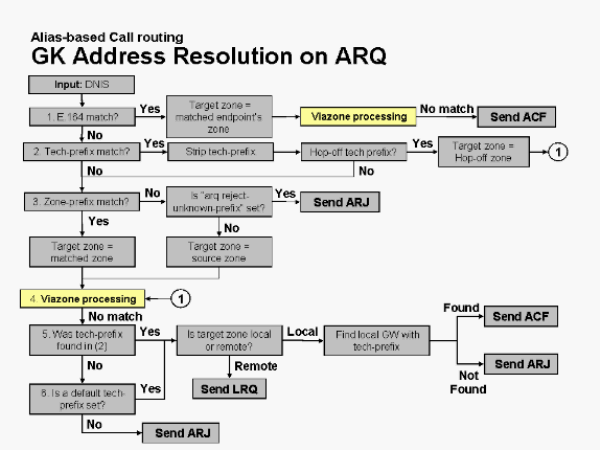
The Voice Infrastructure and Application (VIA) functions are software enhancements to the existing Cisco gatekeeper image. With this enhancement, the Cisco gatekeeper can recognize two call legs on the same platform (IP-to-IP gateway) and also load-balance traffic across multiple IP-to-IP gateways, which are included (both gateways and gatekeepers) in a predefined VIA zone. These gatekeepers sit at the edge of the Internet Telephony Service Provider (ITSP) network and are like a VoIP transfer point, or transit zone, where VoIP traffic is channeled through on the way to the remote zone destination. IP-to-IP gateways in the VIA zone terminate incoming calls and reoriginate them toward their final destinations. Refer to Remote to Local Network with the Cisco Multiservice IP-to-IP Gateway Feature for more information on VIA zone.
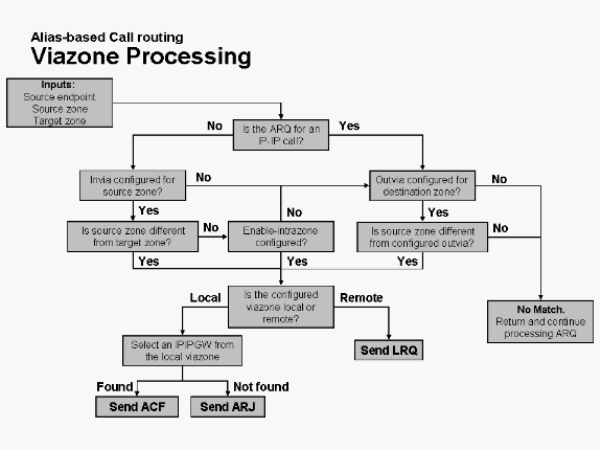
Note: If the specified invia or outvia zone is not found in the configs (i.e. it is not defined as either a local or remote zone), then an ARJ message is sent.
In order to select an IP-IP GW registered to the selected viazone this algorithm is used:
-
If a tech-prefix is found (in alias-based matching), look through the list of gateways in the specified viazone that have registered this tech-prefix.
-
If no tech-prefix is found, look through the entire list of gateways registered to the specified viazone.
-
Select the first IP-IP GW found in step 1 or 2 that has resources available.
-
If all the IP-IP GWs in the list are out of resources, select the first IP-IP GW that is found (even though it might be out of resources).
-
If no IP-IP GWs are found, return failure.
Local Zone Call Examples
In the examples provided in this section, the two gateways register with the Cisco gatekeeper with their respective H.323 IDs. In addition, gateway (GWY) A2 registers with an E.164 address. This diagram is used for all the examples in this section:
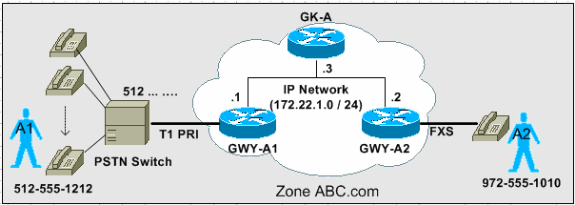
The three scenarios in this section explain the step-by-step decision process the gatekeeper uses to route calls based on the ARQ messages.
Note: Only relevant output is shown in these configuration captures.
Scenario 1: No Technology Prefixes Configured
| GK-A | |
|---|---|
! gatekeeper zone local GK-A abc.com no shutdown ! |
|
| GWY-A1 | GWY-A2 |
! interface Ethernet0/0 ip address 172.22.1.1 255.255.255.0 h323-gateway voip interface h323-gateway voip id GK-A ipaddr 172.22.1.3 1718 !--- The IP address configured here should !--- be the RAS address of GK-A !--- and should be reachable from the gateway. !--- In order to find out the RAS address, !--- issue the show gatekeeper zone status !--- command on GK-A. h323-gateway voip h323-id GW-A1@abc.com ! dial-peer voice 1 pots destination-pattern 512....... direct-inward-dial port 1/0:23 prefix 512 !--- On outgoing calls through POTS dial-peers, !--- all explicit digit matches are dropped, !--- which is the reason !--- for adding the prefix 512. This has nothing to !--- do with technology prefixes. ! dial-peer voice 2 voip destination-pattern 972....... session target ras !--- Uses RAS messages (GK) to get !--- call setup information. ! gateway ! |
! interface FastEthernet0/0 ip address 172.22.1.2 255.255.255.0 h323-gateway voip interface h323-gateway voip id GK-A ipaddr 172.22.1.3 1718 !--- The IP address configured here !--- should be the RAS address of GK-A. !--- and should be reachable from the gateway. !--- In order to find out the RAS address, !--- issue the show gatekeeper zone status !--- command on GK-A. h323-gateway voip h323-id GW-A2@abc.com ! dial-peer voice 1 voip destination-pattern 512....... session target ras ! dial-peer voice 2 pots destination-pattern 9725551010 port 1/0/0 !--- This is the FXS port. ! gateway ! |
This output captured on GK-A displays the actual registrations. Notice GWY-A2 also registers the E.164 ID of the FXS port.
GK-A#show gatekeeper endpoints
GATEKEEPER ENDPOINT REGISTRATION
================================
CallSignalAddr Port RASSignalAddr Port Zone Name Type F
--------------- ----- --------------- ----- --------- ---- --
172.22.1.1 1720 172.22.1.1 49317 GK-A VOIP-GW
H323-ID: GW-A1@abc.com
172.22.1.2 1720 172.22.1.2 58196 GK-A VOIP-GW
E164-ID: 9725551010
H323-ID: GW-A2@abc.com
Total number of active registrations = 2
First Call Action: User A1 calls user A2 at 972-555-1010. Use the ARQ diagram to complete the decision process.
GK-A receives ARQ from GWY-A1.
-
Does the technology prefix match? No
-
Does the zone prefix match? No
-
Is the arq reject-unknown-prefix command set? No, target-zone equals local zone.
-
Is the target-zone local? Yes
-
Was a technology prefix found in step 1? No
-
Is the target address registered? Yes. Send ACF.
Call setup successful.
Note: GWY-A2 has the destination E.164 ID registered (FXS port). Therefore, the gatekeeper was able to admit the call.
Second Call Action: User A2 dials 512-555-1212 to call user A1.
GK-A receives ARQ from GWY-A2.
-
Does the technology prefix match? No
-
Does the zone prefix match? No
-
Is the arq reject-unknown-prefix command set? No, the target-zone equals local zone.
-
Is the target-zone local? Yes
-
Was a technology prefix found in step 1? No
-
Is the target address registered? No
-
Is the default technology prefix set? No. Send ARJ.
Call setup failed.
Note: Scenario 2 explains how to fix this call routing problem with technology prefixes.
Scenario 2: Technology Prefixes Configured
In this scenario, these configuration changes are made:
-
GWY-A1—Added the h323-gateway voip tech-prefix 1# command. GWY-A1 registers to the GK-A with technology prefix 1#.
-
GWY-A1—Added a POTS dial-peer with a destination-pattern command that matches the incoming called number from GWY-A2 with technology prefix 1#.
-
GK-A—Added the zone prefix GK-A command. Defines the local zone prefixes GK-A manages.
-
GK-A—Added the arq reject-unknown-prefix command. This enforces GK-A to accept only ARQ calls for zone prefixes it manages. In scenario 1, this was not configured. Therefore, the target zone was set to the local zone as default.
-
GWY-A2—Added the tech-prefix 1# command under the VoIP dial-peer configuration. This way, GWY-A2 prepends the digits 1# to outgoing VoIP calls. GK-A identifies the 1# pattern to select GWY-A1 as the destination gateway.
| GK-A | |
|---|---|
gatekeeper zone local GK-A abc.com zone prefix GK-A 512....... zone prefix GK-A 972....... arq reject-unknown-prefix no shutdown ! |
|
| GWY-A1 | GWY-A2 |
! interface Ethernet0/0 ip address 172.22.1.1 255.255.255.0 h323-gateway voip interface h323-gateway voip id GK-A ipaddr 172.22.1.3 1718 h323-gateway voip h323-id GW-A1@abc.com h323-gateway voip tech-prefix 1# ! dial-peer voice 3 pots incoming called-number 972....... destination-pattern 1#512....... direct-inward-dial port 1/0:23 prefix 512 ! dial-peer voice 2 voip destination-pattern 972....... session target ras ! gateway ! |
! dial-peer voice 1 voip destination-pattern 512....... session target ras tech-prefix 1# ! dial-peer voice 2 pots destination-pattern 9725551010 port 1/0/0 ! gateway ! interface FastEthernet0/0 ip address 172.22.1.2 255.255.255.0 h323-gateway voip interface h323-gateway voip id GK-A ipaddr 172.22.1.3 1718 h323-gateway voip h323-id GW-A2@abc.com ! |
This output captured on GK-A displays the registered technology prefixes:
GK-A#show gatekeeper gw-type-prefix
GATEWAY TYPE PREFIX TABLE
=========================
Prefix: 1#*
Zone GK-A master gateway list:
172.22.1.1:1720 GW-A1
Note: Instead of configuring GW-A1 with the h323-gateway voip tech-prefix 1# command, it can be accomplished the same way by manually configuring this information in the GK-A with the command.
GK-A(config-gk)#gw-type-prefix 1#* gw ipaddr 172.22.1.1
Call Action: User A2 dials 512-555-1212 to call user A1.
GK-A receives ARQ from GWY-A2.
-
Does the technology prefix match? Yes
Note: After the technology prefix match, the gatekeeper strips it to analyze the zone prefix. This strip is only performed by the gatekeeper analysis. The originating gateway still appends it in the call setup to the terminating gateway.
-
Does the zone prefix match? Yes. Set the target-zone to equal the local zone.
-
Does the alias name (after stripping tech prefix) match with any registered GW? No. (If Yes, send ACF).
-
Is the target-zone local? Yes
-
Was a technology prefix found in step 1? Yes
-
Was a local gateway with a technology prefix found? Yes. Send ACF .
Call setup success.
This GK-A debug command output illustrates the above behavior.
Note: This debug command is a useful, but hidden, debug. Therefore, the parser does not show the debug.
GK-A#debug gatekeeper main 5
*Jun 19 09:50:10.086: gk_rassrv_arq: arqp=0x631CC400, crv=0x82, answerCall=0
*Jun 19 09:50:10.086: gk_dns_locate_gk(): No Name servers
*Jun 19 09:50:10.086: rassrv_get_addrinfo(1#5125551010): Matched tech-prefix 1#
*Jun 19 09:50:10.086: rassrv_get_addrinfo(1#5125551010): Matched zone prefix 512
*Jun 19 09:50:10.118: gk_rassrv_arq: arqp=0x631CC400, crv=0x1A, answerCall=1
Note: This is an alternative configuration that can be more intuitive:
-
Issue the h323-gateway voip tech-prefix 512 command in order to configure GWY-A1 to register with technology prefix 512.
-
This way, GWY-A2 does not have to pass the prefix in the VoIP dial-peer call leg because the destination-pattern already includes 512. Therefore, take out the tech-prefix 1# command in the GWY-A2 configuration and also remove 1# from the destination-pattern under the pots dial peer on GWY-A1.
Scenario 3: Default Technology Prefixes Configured
In this scenario, GWY-A1 registers with technology prefix 1# and GK-A is configured to route calls without a technology prefix match to the default technology prefix gateways. Therefore, GWY-A2 does not need to be configured to pass the destination technology prefix.
| GK-A | |
|---|---|
! gatekeeper zone local GK-A abc.com zone prefix GK-A 512....... zone prefix GK-A 972....... gw-type-prefix 1#* default-technology arq reject-unknown-prefix no shutdown ! |
|
| GWY-A1 | GWY-A2 |
! interface Ethernet0/0 ip address 172.22.1.1 255.255.255.0 h323-gateway voip interface h323-gateway voip id GK-A ipaddr 172.22.1.3 1718 h323-gateway voip h323-id GW-A1@abc.com h323-gateway voip tech-prefix 1# ! dial-peer voice 1 pots destination-pattern 512....... direct-inward-dial port 1/0:23 prefix 512 ! dial-peer voice 2 voip destination-pattern 972....... session target ras ! gateway ! |
! dial-peer voice 1 voip destination-pattern 512....... session target ras ! dial-peer voice 2 pots destination-pattern 9725551010 port 1/0/0 ! gateway ! interface FastEthernet0/0 ip address 172.22.1.2 255.255.255.0 h323-gateway voip interface h323-gateway voip id GK-A ipaddr 172.22.1.3 1718 h323-gateway voip h323-id GW-A2@abc.com ! |
This output captured on GK-A displays the registered technology prefixes:
GK-A#show gatekeeper gw-type-prefix
GATEWAY TYPE PREFIX TABLE
=========================
Prefix: 1#* (Default gateway-technology)
Zone GK-A master gateway list:
172.22.1.1:1720 GW-A1
Call Action: User A2 dials 512-555-1212 to call user A1.
GK-A receives ARQ from GWY-A2.
-
Does the technology prefix match? No
-
Does the zone prefix match? Yes. Set the target-zone to equal the local zone.
-
Is the target-zone local? Yes
-
Was a technology prefix found in step 1? No
-
Is the target address registered? No
-
Is the default technology prefix set? Yes. Select the local gateway with the technology prefix (only one available).
-
Send ACF.
Call setup successful.
Remote Zone Call Examples
In these examples, there are two H.323 zones: one controlled by GK-A and another by GK-B.

The scenarios in this section explain the step-by-step decision process the gatekeepers use to route calls based on the ARQ and LRQ messages.
Note: Only relevant output is shown in these configuration examples.
Scenario 1: Zone Gatekeepers Configured with Default Technology Prefixes
In this scenario, GWY-A1 registers to GK-A with technology prefix 1# and GWY-B1 registers to GK-B with technology prefix 2#. Both gatekeepers are configured with default technology prefix gateways.
| GK-A | GK-B |
|---|---|
! gatekeeper zone local GK-A abc.com 172.22.1.3 zone remote GK-B abc.com 172.22.2.3 1719 zone prefix GK-B 214....... zone prefix GK-A 512....... gw-type-prefix 1#* default-technology arq reject-unknown-prefix no shutdown ! |
! gatekeeper zone local GK-B abc.com 172.22.2.3 zone remote GK-A abc.com 172.22.1.3 1719 zone prefix GK-B 214....... zone prefix GK-A 512....... gw-type-prefix 2#* default-technology no shutdown ! |
| GWY-A1 | GWY-B1 |
! interface Ethernet0/0 ip address 172.22.1.1 255.255.255.0 half-duplex h323-gateway voip interface h323-gateway voip id GK-A ipaddr 172.22.1.3 1718 h323-gateway voip h323-id GW-A1@abc.com h323-gateway voip tech-prefix 1# ! dial-peer voice 1 pots destination-pattern 512....... direct-inward-dial port 1/0:23 prefix 512 ! dial-peer voice 2 voip destination-pattern .......... session target ras ! gateway |
! interface Ethernet0/0 ip address 172.22.2.1 255.255.255.0 h323-gateway voip interface h323-gateway voip id GK-B ipaddr 172.22.2.3 1718 h323-gateway voip h323-id GWY-B1@abc.com h323-gateway voip tech-prefix 2# ! dial-peer voice 1 pots destination-pattern 214....... direct-inward-dial port 3/0:23 prefix 214 ! dial-peer voice 2 voip destination-pattern T session target ras ! gateway ! |
Call Action: User A1 dials 214-555-1111 to call user B1.
GK-A receives ARQ from GWY-A1.
-
Does the technology prefix match? No
-
Does the zone prefix match? Yes. Set the target-zone to equal the remote GK-B zone (214).
-
Is the target zone local? No
-
Send LRQ to GK-B.
GK-B receives LRQ from GK-A.
-
Does the technology prefix match? No
-
Does the zone prefix match? Yes. Set the target-zone to equal the local zone.
-
Is the target zone local? Yes
-
Was a technology prefix found in step 1? No
-
Is the target address registered? No
-
Is the default technology prefix set? Yes. Select the local gateway with the technology prefix (2#).
-
Send LCF to GK-A.
GK-A receives LCF from GK-B with terminating gateway information.
GK-A sends ACF to GWY-A1.
The call setup is successful.
Scenario 2: Zone Gatekeepers Configured without Default Technology Prefixes
In this scenario, GWY-A1 registers to GK-A with technology prefix 1# and GWY-B1 registers to GK-B with technology prefix 2#. GWY-A1 adds technology prefix 2# to the called number string when making calls to (214) and GWY-B1 adds technology prefix 1# to the called number string when making calls to (512).
| GK-A | GK-B |
|---|---|
! gatekeeper zone local GK-A abc.com zone remote GK-B abc.com 172.22.2.3 1719 zone prefix GK-B 214* zone prefix GK-A 512* arq reject-unknown-prefix no shutdown ! |
! gatekeeper zone local GK-B abc.com 172.22.2.3 zone remote GK-A abc.com 172.22.1.3 1719 zone prefix GK-B 214* zone prefix GK-A 512* no shutdown ! |
| GWY-A1 | GWY-B1 |
! interface Ethernet0/0 ip address 172.22.1.1 255.255.255.0 half-duplex h323-gateway voip interface h323-gateway voip id GK-A ipaddr 172.22.1.3 1718 h323-gateway voip h323-id GW-A1@abc.com h323-gateway voip tech-prefix 1# ! dial-peer voice 1 pots destination-pattern 512....... direct-inward-dial port 1/0:23 prefix 512 ! dial-peer voice 2 voip destination-pattern 214....... session target ras tech-prefix 2# ! gateway |
! interface Ethernet0/0 ip address 172.22.2.1 255.255.255.0 h323-gateway voip interface h323-gateway voip id GK-B ipaddr 172.22.2.3 1718 h323-gateway voip h323-id GWY-B1@abc.com h323-gateway voip tech-prefix 2# ! dial-peer voice 1 pots destination-pattern 214....... direct-inward-dial port 3/0:23 prefix 214 ! dial-peer voice 2 voip destination-pattern T session target ras tech-prefix 1# ! gateway ! |
First Call Action: User B1 dials 512-555-1212 to call user A1.
GK-B receives ARQ from GWY-B1.
-
Does the technology prefix match? No
-
Does the zone prefix match? No
Note: Because GK-B is not aware of a 1# technology prefix, it assumes it is part of the called number and reads it as a zone prefix.
-
Is the target zone local? Yes
Note: GK-B takes the default target zone equals local zone because the arq reject-unknown-prefix command is not set.
-
Was a technology prefix found in step 1? No
-
Is the target address registered? No
-
Is the default technology prefix set? No
-
Send ARJ to GWY-B1.
Call setup failed.
This output was captured in GK-B to further illustrate this behavior:
!--- From debug gatekeeper main 5.
GK-B#
gk_rassrv_arq: arqp=0x62F6A7E0, crv=0x22, answerCall=0
gk_dns_locate_gk(): No Name servers
rassrv_get_addrinfo(1#5125551212): Tech-prefix match failed
rassrv_get_addrinfo(1#5125551212): unresolved zone prefix, using source zone GK-B
rassrv_get_addrinfo(1#5125551212): unknown address and no default technology defined
gk_rassrv_sep_arq(): rassrv_get_addrinfo() failed (return code = 0x103)
!--- From debug ras.
GK-B#
RecvUDP_IPSockData successfully rcvd message of length 156 from 172.22.2.1:51141
ARQ (seq# 1796) rcvdparse_arq_nonstd: ARQ Nonstd decode succeeded, remlen= 156
IPSOCK_RAS_sendto: msg length 4 from 172.22.2.3:1719 to 172.22.2.1: 51141
RASLib::RASSendARJ: ARJ (seq# 1796) sent to 172.22.2.1
Configure the gatekeepers to identify the remote zone technology prefixes in order to fix this problem.
-
Add this to GK-B:
GK-B(config-gk)#gw-type-prefix 1# hopoff GK-A
-
Add this to GK-A:
GK-A(config-gk)#gw-type-prefix 2# hopoff GK-B
Notice that the POTS dial-peer in the terminating gateways needed to be updated to match the incoming dial strings with the technology prefixes.
| GK-A | GK-B |
|---|---|
! gatekeeper zone local GK-A abc.com zone remote GK-B abc.com 172.22.2.3 1719 zone prefix GK-B 214* zone prefix GK-A 512* arq reject-unknown-prefix gw-type-prefix 2# hopoff GK-B no shutdown ! |
! gatekeeper zone local GK-B abc.com 172.22.2.3 zone remote GK-A abc.com 172.22.1.3 1719 zone prefix GK-B 214* zone prefix GK-A 512* gw-type-prefix 1# hopoff GK-A no shutdown ! |
| GK-B | GWY-B1 |
! interface Ethernet0/0 ip address 172.22.1.1 255.255.255.0 half-duplex h323-gateway voip interface h323-gateway voip id GK-A ipaddr 172.22.1.3 1718 h323-gateway voip h323-id GW-A1@abc.com h323-gateway voip tech-prefix 1# ! !--- This dial-peer is used for !--- incoming calls from the PSTN. dial-peer voice 1 pots incoming called-number 512....... direct-inward-dial port 1/0:23 ! dial-peer voice 2 voip destination-pattern 214....... session target ras tech-prefix 2# ! !--- This dial-peer is used to !--- terminate (512) calls coming !--- from the VoIP network. Notice !--- that the technology prefix !--- is matched to select the dial-peer !--- but does not pass it to !--- the PSTN. dial-peer voice 3 pots destination-pattern 1#512....... direct-inward-dial port 1/0:23 prefix 512 ! dial-peer voice 4 voip destination-pattern 972....... session target ras ! gateway |
! interface Ethernet0/0 ip address 172.22.2.1 255.255.255.0 h323-gateway voip interface h323-gateway voip id GK-B ipaddr 172.22.2.3 1718 h323-gateway voip h323-id GWY-B1@abc.com h323-gateway voip tech-prefix 2# ! dial-peer voice 1 pots incoming called-number 214....... direct-inward-dial port 3/0:23 prefix 214 ! dial-peer voice 2 voip destination-pattern T session target ras tech-prefix 1# ! dial-peer voice 3 pots destination-pattern 2#214....... port 3/0:23 prefix 214 ! gateway ! |
Second Call Action: User B1 dials 512-555-1212 to call user A1.
GK-B receives ARQ from GWY-B1.
-
Does the technology prefix match? Yes
-
Is there a hop-off technology prefix? Yes
-
Send LRQ to GK-A.
Note: The LRQ includes the technology prefix in the called number for GK-A analysis.
GK-A receives LRQ from GK-B.
-
Does the technology prefix match? Yes
-
Is there a hop-off technology prefix? No
Note: In order to continue the call routing analysis, GK-A strips the technology prefix. The technology prefix does remain in the called number string when the gateways set up the call legs.
-
Does the zone prefix match? Yes. Set the target-zone to equal the local zone.
-
Is the target-zone local? Yes
-
Was a technology prefix found in step 1? Yes
-
Did you find a local gateway with a technology prefix? Yes
-
Send LCF to GK-B.
GK-B receives LCF from GK-A with terminating gateway information.
GK-B sends ACF to GWY-B1.
Call setup successful.
This command output was captured in GK-B to further illustrate this behavior:
!--- From debug gatekeeper main 5. GK-B# gk_rassrv_arq: arqp=0x62ED2D68, crv=0x24, answerCall=0 gk_dns_locate_gk(): No Name servers rassrv_get_addrinfo(1#5125551212): Matched tech-prefix 1# rassrv_put_remote_zones_from_zone_list() zone GK-A gk_rassrv_irr: irrp=0x62F0D8FC, from 172.22.2.1:51141 GK-B# GK-B# !--- From debug ras. RecvUDP_IPSockData successfully received message of length 156 from 172.22.2.1:51141 ARQ (seq# 1809) rcvdparse_arq_nonstd: ARQ Nonstd decode succeeded, remlen= 156 IPSOCK_RAS_sendto: msg length 104 from 172.22.2.3:1719 to 172.22.1.3: 1719 RASLib::RASSendLRQ: LRQ (seq# 1042) sent to 172.22.1.3 IPSOCK_RAS_sendto: msg length 7 from 172.22.2.3:1719 to 172.22.2.1: 51141 RASLib::RASSendRIP: RIP (seq# 1809) sent to 172.22.2.1 RecvUDP_IPSockData successfully rcvd message of length 131 from 172.22.1.3:1719 LCF (seq# 1042) rcvdparse_lcf_nonstd: LCF Nonstd decode succeeded, remlen= 131 IPSOCK_RAS_sendto: msg length 34 from 172.22.2.3:1719 to 172.22.2.1: 51141 RASLib::RASSendACF: ACF (seq# 1809) sent to 172.22.2.1 RecvUDP_IPSockData successfully rcvd message of length 76 from 172.22.2.1:51141
Verification and Troubleshooting Commands
This section provides a list of show and debug commands that are used to verify and troubleshoot gatekeeper and gateway call routing issues.
The Output Interpreter Tool (registered customers only) (OIT) supports certain show commands. Use the OIT to view an analysis of show command output.
Note: Refer to Important Information on Debug Commands before you use debug commands.
-
show gateway—Used to verify E.164 and H.323 alias registration for the gateway.
-
show gatekeeper endpoints—Used to verify the E.164 and H.323 alias registered with the gatekeeper.
-
show gatekeeper gw-type-prefix—Used to verify E.164 prefix registrations on the gatekeeper.
-
show gatekeeper zone prefix | status—Used to verify zone status and configuration parameters.
-
debug ras—Applicable for gateways and gatekeepers.
-
debug h225 asn1—Applicable for gateways and gatekeepers.
-
show dial-peer voice—Used to verify configured technology prefixes under the dial-peers.
Related Information
- Understanding H.323 Gatekeepers
- Troubleshooting Gatekeeper Registration Issues
- Voice - Understanding How Inbound and Outbound Dial Peers are Matched on Cisco IOS Platforms
- Voice Technology Support
- Voice and Unified Communications Product Support
- Troubleshooting Cisco IP Telephony

- Technical Support & Documentation - Cisco Systems
 Feedback
Feedback